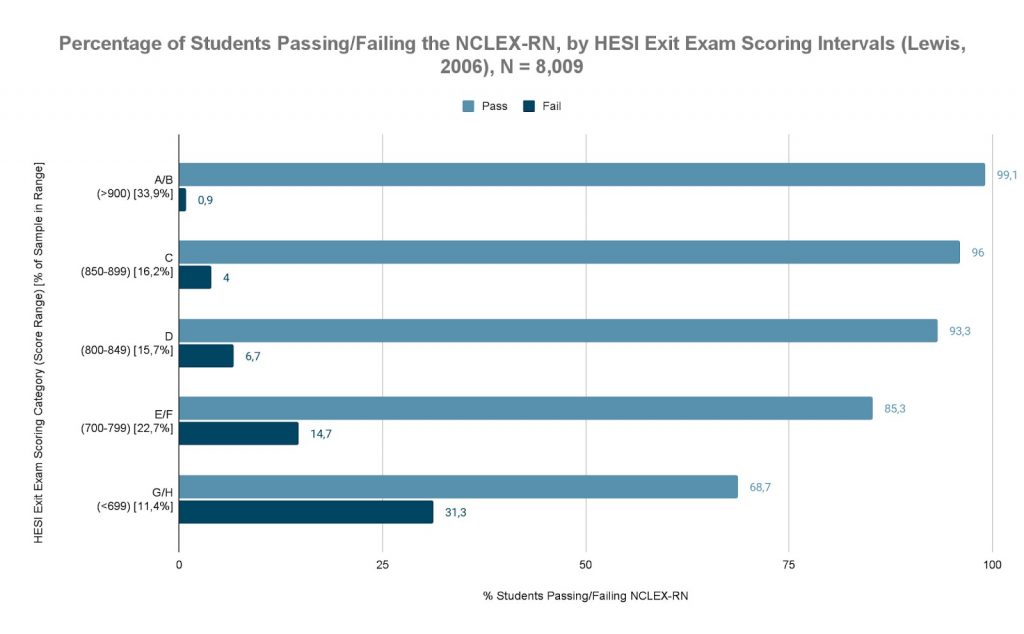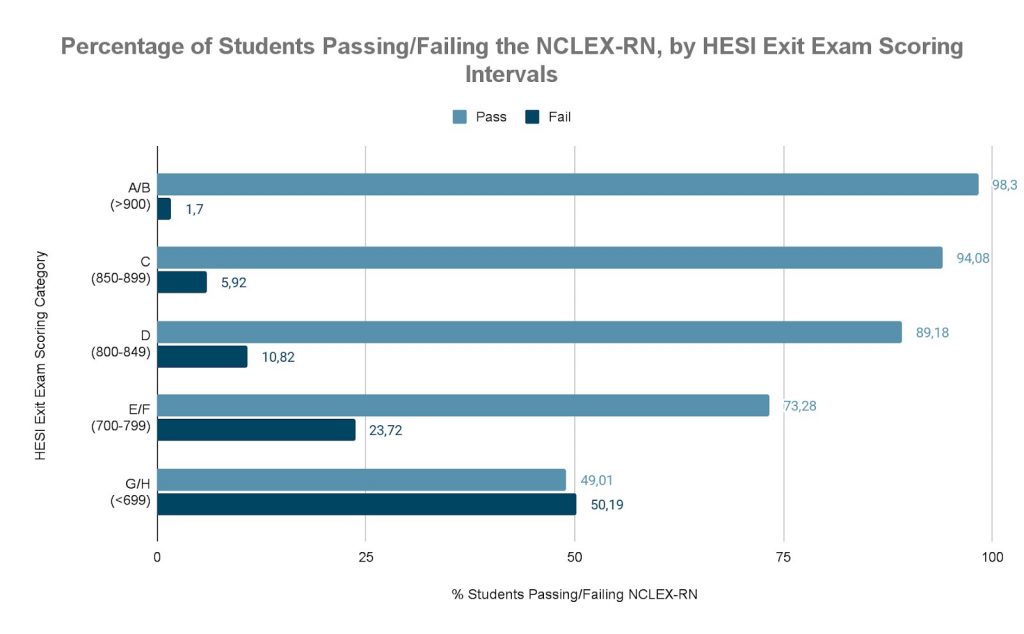You’ll soon get familiar with the HESI exam – which is a necessary entrance exam for many nursing programs – if you’re thinking about attending nursing school or are already enrolled.
The HESI exam is a reliable indicator of nursing students’ success, and many schools include it in the requirements for admission. Exams and study materials from HESI are available to nursing students throughout their degree. HESI is not used by all colleges and institutions. Yet, helping students prepare for and pass their licensure exams is gaining popularity.
Reviewing the HESI exit exam and NCLEX pass rate will provide you a comprehensive understanding of both tests and help you develop an effective study strategy. With the help of our website’s free HESI A2 practice test, you can review all of your foundational information.
HESI Exit Exam: Progression and Graduation policies
It’s hard to predict the likelihood of a nursing student passing and graduating from the NCLEX for the first time due to the numerous interacting variables that influence success or failure (Uyehara, Magnussen, Itano, & Zhang, 2007). Many nursing programs use standardized assessment programs to predict the success of students on the NCLEX despite this difficulty, (Holstein et al., 2006). And many schools have policies that until students have reached certain scores on these tests, they are precluded from graduating.
According to data collected by the NLN in a 2011 survey, 20% of RN programs require a minimum score to graduate, 33% required a minimum score on a standardized test to progress, and 12% will not allow students to register for the board exam until they get a minimum score. However, as Spurlock (2006) has indicated, there is little to no guidance available to faculty who would like to set cut, or decision, scores for their graduation or progression policies, and there are no accepted policies in place as to how to best implement standardized examination (NLN, 2012).
This process of using these tests to allow for graduation and progression is also known as “high-stakes” testing (NLN, 2012). The Assessment Technologies Institute and Health Educational Systems, Inc., (HESI) are two of the most often used testing programs in high-stakes testing (ATI). Many schools use the HESI Exit Exam (E2 ) as an NCLEX predictor test, despite the fact that both firms offer a suite of exams.
HESI has a host of assessment products, but the HESI exit exam (E2) is the one most often used to “predict” NCLEX success. The HESI E2 is a 150-item comprehensive exam that uses a blueprint similar to that of the NCLEX-RN exam to assess student preparedness for the NCLEX-RN.
Individual student scores are linked to a reported likelihood of passing the NCLEX-RN in most of the commercially available standardized predictive tests. The typical cut-score for the HESI Exit Exam (E2) is 850, while some schools use a 900 cut score. (For HESI scores and their reported “correlation” to NCLEX success, see Table 1).
| HESI Score | Correlation to NCLEX Success |
|---|---|
| A: >950 | Outstanding probability of passing |
| B: 900-940.9 | Excellent probability of passing |
| C: 850-899.0 | Average probability of passing |
| D: 800-849.9 | Below average probability of passing |
| E: 750-799.9 | Additional preparation needed |
| F: 700-749.9 | Serious preparation needed |
| G: 650-699.9 | Grave danger of failing |
| H: <649 | Poor performance expected |
Table 1: HESI Exam categories, scoring intervals, and expectations
HESI Exit Exam and NCLEX Pass Rates
To further explain this point, I’ve included additional graphs and study summaries below. Figure 1 is based on data from Lewis (2006), as given by Spurlock (2012) about the HESI score and NCLEX pass rate.

Figure 1: Percentage of students passing/failing the NCLEX-RN exam
Figure 1 shows that a significant majority of students pass the NCLEX in all scoring categories. Students scoring 850 or above have between 96-99.1% pass rate, but even those scoring between 700-799 pass 85.3% of the time (and that is ABOVE the national average in 2013 which was 83% down from 2012 of 90.34%).
Only 13% of individuals in the “do not progress” group actually failed the NCLEX when they took it when using a cut score of 900 (above which students progress, below which they do not). This indicates that 87% who have been told they have not met the “standard” could actually pass the NCLEX.
Figure 2 is based on data from Nibert, A. T., Young, A., and Adamson, C. (2002), as reported by Spurlock (2102).

Figure 2: Percentage of students passing/failing the NCLEX-RN exam
The proportion of students in each category of the total population (N = 5,903) was as follows:
- A/B: 35%,
- C: 17%,
- D: 17%,
- E/F: 22%,
- G/H: 9%
When using a cut score of 900, Nibert et al. (2002) discovered that just 19% of those in the “do not progress” group actually failed the NCLEX when they took it—again, the HESI exam was incorrect for 81% of this group.
A total of 2,613 RN students (1,991 ADN, 563 BSN, and 59 diplomas) took the HESI E2 in another study (Lauchner, Newman, & Britt, 2008). Colleges were required to report the number of students predicted by the HESI E2 to pass the NCLEX but did NOT pass.
The exams were scored using “HESI’s predictability model,” which has not been described in the literature, making it difficult to assess its validity or effectiveness.
The results are listed in the table below. Low percentages of students expected to pass (for example, 49% of ADN students and 42% of BSN students) and low numbers of students who were predicted to pass but did not. This means that the HESI Exit Exam is generating a large number of false-negative results, or telling a large number of people they won’t pass when they actually do, and only telling a small number that they will pass when they actually don’t.
The following is the most striking aspect of the presented results: When we look at the overall number of RNs, we can see from Table 2 that 1,248 RN students (48.4% of the total sample) were expected to pass the NCLEX. 34 of the 1,248 students who were expected to pass failed. This corresponds to an “error rate” of 2.7%.
However, what about the 1,307 students who were not expected to pass? What was the outcome of their test?
If they’re not expected to pass, they were very certainly expected to fail, but we don’t know if they did. And if they didn’t fail, this should be taken into consideration when assessing the accuracy of the predictions. There were 1,307 students in this sample who were not expected to pass. And the results would be considerably different if they passed at the national NCLEX passing average of 86.7% in 2008.
There would have been 1,133 students who passed when they were informed they would fail if the remaining students who were NOT expected to pass ended up passing at the national average. This means that the predictive model was 86.7% wrong.
HESI Exit Exam Predicted Passes on the NCLEX Exam that Failed by Program
| Program | Number (%) of Respondents | Number (%) of Respondents Predicted to Pass | Number of Predicted Passes that Failed | |
|---|---|---|---|---|
| Registered Nurse | Associate Degree Students | 1976 (77,34) | 986 (49,90) | 27 |
| Baccalaureate Students | 520 (20,35) | 218 (41,92) | 7 | |
| Diploma | 59 (2,31) | 44 (74,58) | 0 | |
| Total RN | 2555 (100) | 1248 (48,84) | 34 | |
| Practical Nurse | 170 (100) | 65 (38,24) | 0 | |
| Total Registered Nurse and Practical Nurse | 2725 (100) | 1313 (48,18) | 34 |
Table 2: Study table indicating HESI Exam Predictions (from Lauchner, Newman, & Britt, 2008)
“The HESI E2 was found to be highly predictive of students’ success on the licensing exam,” the study continues goes on to say. The accuracy of HESI E2 predictions of NCLEX success was so close to the students’ actual outcomes on the licensing exam that the odds of these results occurring by chance alone infinitesimal…” (according to Lauchner, Newman, & Britt, 2008, p.7).
NCLEX Pass Rates 2022
Number of Candidates Taking The NCLEX Exam and Pass Rates, by Type of Candidate
| RN | Jan-March3 | April-June | July-Sep | Oct-Dec | Year to Date Total | |||||
|---|---|---|---|---|---|---|---|---|---|---|
| Type of Candidate | #1 | 0.02 | # | % | # | % | # | % | # | % |
| First Time, US Educated | ||||||||||
| Diploma | 481 | 79.83% | 762 | 81.10% | 794 | 80.60% | 259 | 71.04% | 2.296 | 79.53% |
| Baccalaureate Degree | 23.399 | 88.09% | 28.407 | 88.97% | 32.325 | 84.38% | 10.177 | 78.65% | 94.308 | 86.06% |
| Associcate Degree | 23.562 | 81.73% | 27.646 | 82.47% | 27.723 | 77.35% | 9.418 | 64.79% | 88.349 | 78.78% |
| Invalid or Special Program Codes | 19 | 52.63% | 22 | 63.64% | 32 | 31.25% | 36 | 38.89% | 109 | 44.04% |
| Total First Time, US Educated | 47.461 | 84.83% | 56.837 | 85.69% | 60.874 | 81.10% | 19.89 | 71.92% | 185.062 | 82.48% |
| Repeat, US Educated | 10.687 | 43.24% | 12.323 | 44.36% | 16.483 | 49.92% | 15.699 | 43.35% | 55.192 | 45.52% |
| First Time, Internationally Educated | 3.364 | 42.99% | 3.926 | 48.65% | 4.63 | 48.71% | 6.602 | 45.97% | 18.495 | 46.68% |
| Repeat, Internationally Educated | 4.439 | 23.72% | 4.827 | 30.39% | 5.167 | 29.53% | 5.633 | 27.02% | 20.066 | 27.75% |
| All Candidateds | 65.951 | 71.85% | 77.913 | 73.86% | 87.127 | 70.43% | 47.824 | 53.67% | 278.815 | 68.85% |
| PN | Jan-March4 | April-June | July-Sep | Oct-Dec | Year to Date Total | |||||
|---|---|---|---|---|---|---|---|---|---|---|
| Type of Candidate | #1 | % | # | % | # | % | # | % | # | % |
| First Time, US Educated | 11.765 | 80.26% | 10.043 | 78.25% | 15.171 | 80.99% | 9.377 | 77.98% | 46.356 | 79.60% |
| Repeat, US Educated | 4.138 | 36.81% | 4.366 | 33.42% | 4.35 | 33.01% | 4.566 | 38.37% | 17.42 | 35.42% |
| First Time, Internationally Educated | 127 | 54.33% | 101 | 51.49% | 105 | 52.38% | 102 | 47.06% | 435 | 51.49% |
| Repeat, Internationally Educated | 183 | 18.03% | 151 | 21.19% | 167 | 14.97% | 159 | 18.87% | 660 | 18.18% |
| All Candidates | 16.213 | 68.26% | 14.661 | 64.13% | 19.793 | 69.74% | 14.204 | 64.36% | 64.871 | 66.92% |
- #: the number of candidates taking the exam.
- %: the percentage of candidates passing the exam.
- The RN Passing Standard is 0.00 logits.
- The PN Passing Standard is -0.18 logits.
FAQs – HESI Exit Exam and NCLEX Pass Rate
What HESI score is equivalent to passing NCLEX?
According to studies, the HESI Exit Exam has a 96-99% estimated rate in predicting NCLEX exam success. That indicates that most students who receive a 900 or higher on the NCLEX exam are likely to pass.
What is a good HESI conversion score?
Generally, a HESI conversion score between 90 and 100% on any of the HESI sections is regarded as excellent. A score of 80% to 89% is considered very good. Typically, a score between 75% and 79% is regarded as satisfactory, while some schools consider scores as low as 70% to be satisfactory.
Is the exit HESI harder than NCLEX?
According to studies, the HESI Exit Exam has a 96-99% estimated prediction of the NCLEX exam success. It means that most students who receive a 900 or higher on the NCLEX exam are likely to pass. Not all, but the majority of students. This is a crucial distinction.
How does the HESI compare to the NCLEX?
Although the NCLEX and HESI exams are both nursing knowledge assessments, the objective of the tests differs significantly. Instead, the HESI gives students to practice before they take the NCLEX, preparing them for the types of questions they’ll see on the actual exam.
What is the passing rate for the HESI?
On a scale of 0 to 100, each section is scored separately. For the HESI exam, schools set their own passing scores. For each section of the exam, most schools require a minimum score of 75%. Some schools, on the other hand, may require students to receive a 75% on one section and an 80% on another.
What is a good score on the HESI exit?
850 or higher
Before graduation, most nursing schools require students to take and pass the HESI exit examination. The minimum passing score to graduate varies by school, but in general, a score of 850 or higher is considered an excellent score.
The HESI exit exam and NCLEX pass rate have both been analyzed. Create an efficient study plan right away to improve your readiness for the actual exam. Use our free HESI A2 practice test to get a feel for the structure and questions of the actual exam, and then ace it on your first try.

PCCN vs CCRN: Which Certification Should I Take?
In this discussion, we will examine the fundamental distinctions between PCCN vs CCRN certifications, allowing you to make an informed and right decision about which certification is best for your nursing career progression.
June 20, 2023

Is PCCN Worth It? A Comprehensive 2024 Study Guide
In this article, we will provide all the enrollment criteria, how to apply, whether is PCCN worth it for you to obtain, and how to get a high mark.
June 20, 2023

PCCN Requirements - How to Become a Progressive Care Certified Nurse?
To become a progressive care nurse, you must first obtain the PCCN certification. This post will help you understand PCCN certification, PCCN requirements, and efficient approaches to obtaining this certification.
June 20, 2023

